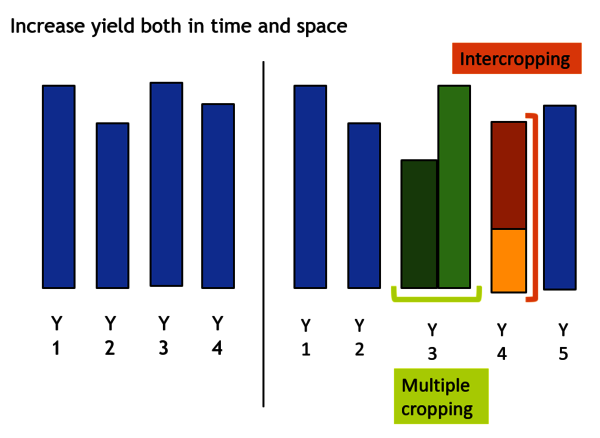We used the network of 10 field experiments providing data from about 100 crop sequences to study the ability of crop diversification to address different challenges: provision of high yields, low use of inputs and reduction of negative environmental impacts. Crop diversification does not always lead to positive effects in all dimensions. However, the results show that regardless of the starting point and the type of agricultural system (conventional or organic), it is possible to design innovative systems which combine higher energy yields, higher gross margins, reduced fertilizer and pesticide use and reduction of greenhouse gas emissions by using specific rules. Thus, through this network, we identified key ingredients to obtain these desired outcomes and avoid trade-offs.
Ingredient 1: Keep a significant proportion of major crops in the diversified sequences to maintain high production and profitability levels and adapt the crop management of these dominant species to the other changes made in the cropping system.
Ingredient 2: Add minor crops to increase both the taxonomic and functional diversity of the crop sequences, thus providing an overall increase in ecosystem service provision. Examples of minor crops to increase ecosystem services are legumes, which reduce the need for nitrogen inputs, or species that have a high weed suppressive ability, such as hemp.
Ingredient 3: Use compensatory agronomic practices (e.g., multiple cropping or intercropping) to increase and secure yields while increasing ecosystem services provision:
- Multiple cropping: several harvests in the same year with additional yields and additional benefits such as higher soil coverage and associated services.
- Intercropping: increase the number of crops that are grown in close proximity within the same land area to secure yields with additional benefits such as weed suppression, higher protein content of the cereal in the case of legume-cereal intercrops, reduction of lodging and reduction of some pest damage.
Ingredient 4: Integrate the above-mentioned components in a systemic manner to address the agronomic and pedoclimatic factors that affect crop production. For instance, to suppress weeds all along the crop sequence, combine different practices such as the addition of suppressive species, intercropping, multiple cropping, undersowing, rotation extension, or alternating winter and spring crops. Think about how major and minor crops could be grown or inserted in the sequence combined with other levers (e.g., intercropping legumes with cereals to reduce their low competitive ability against weeds or risk of lodging).
Ingredient 5: Use adaptive management. Adapting continuously the diversification process, i.e., crops and practices, to face different extreme climatic events or biotic factors and evolving socio-economic factors (e.g. infrastructure, markets, regulations, available knowledge).

 tap and then scroll down to the Add to Home Screen command.
tap and then scroll down to the Add to Home Screen command.
Disqus
In order to use the comment function, you must register with the third-party provider "Disqus".
When you activate this function, your browser establishes a direct connection with the servers of the third-party provider. We would like to point out that data is transmitted to the third-party provider after activation, and the latter may set cookies that can also be used for analysis and marketing purposes. For more information, please refer to our privacy policy.
Activate